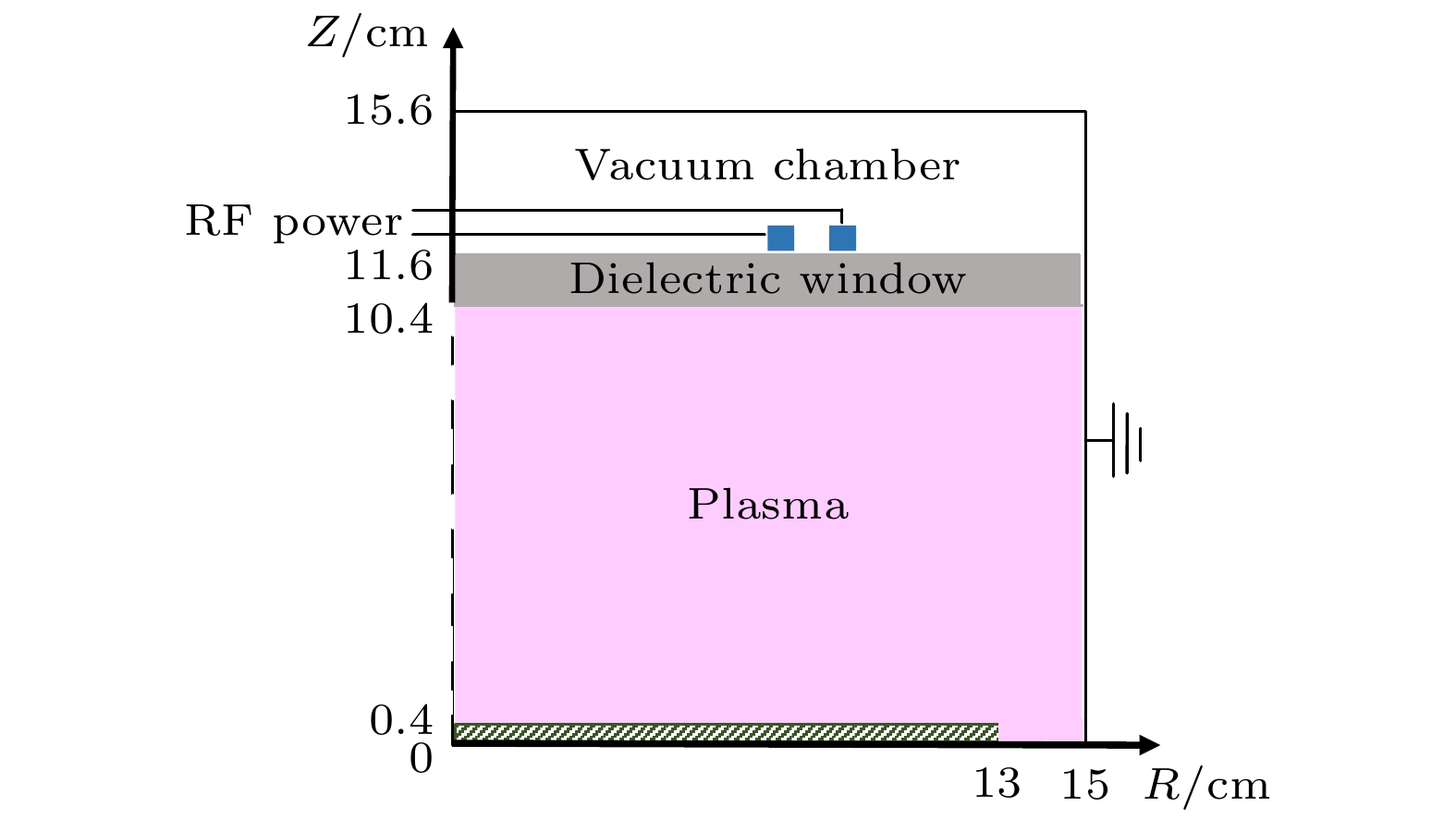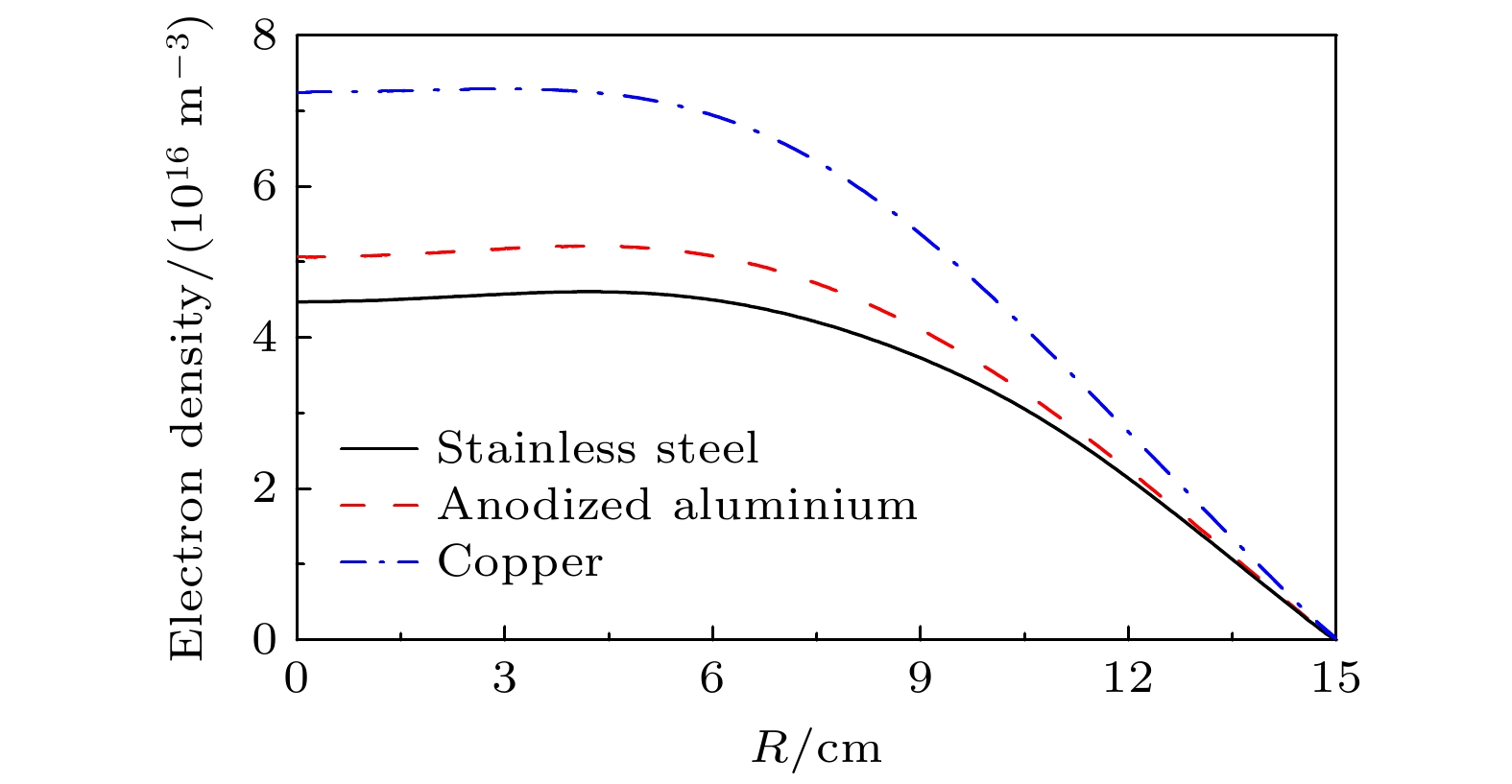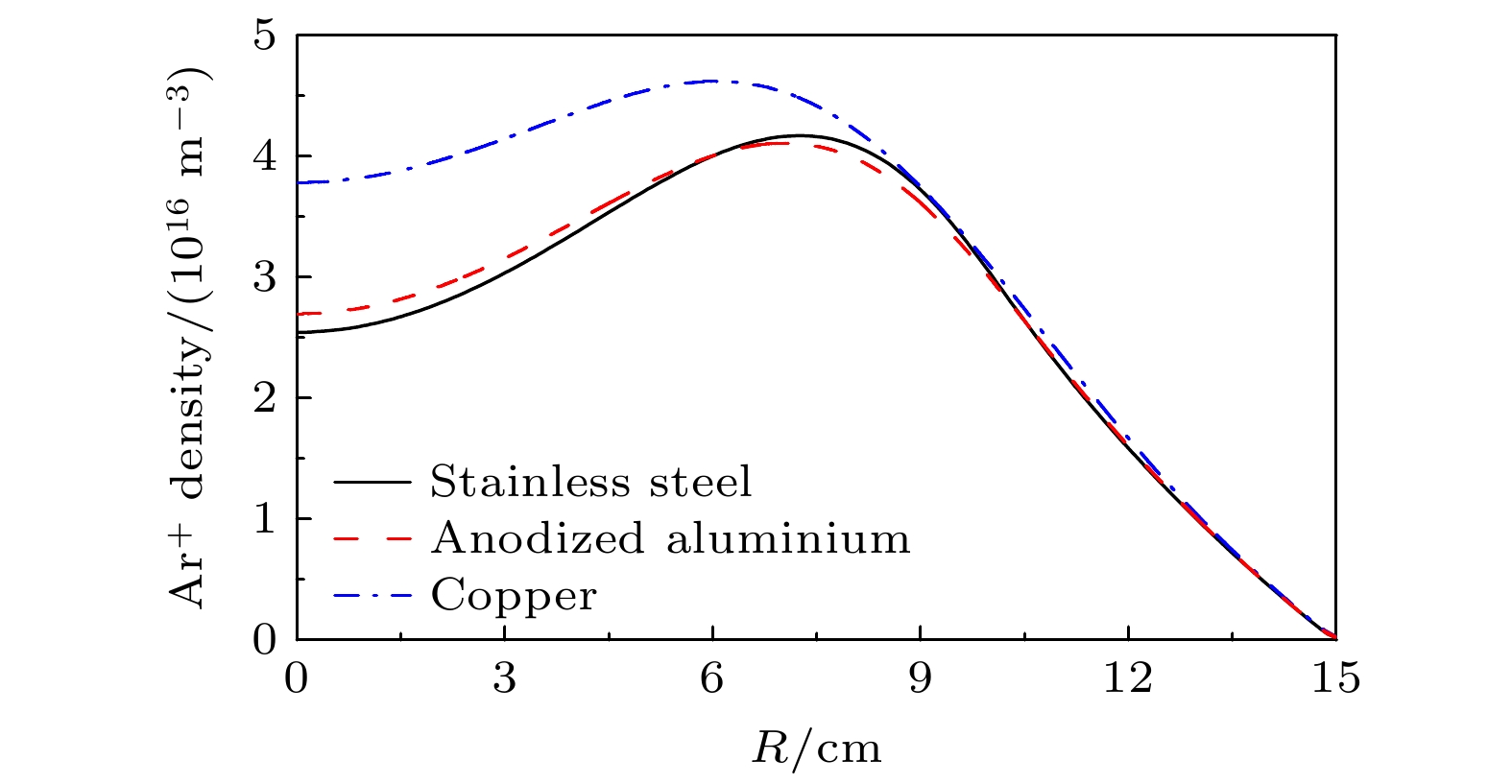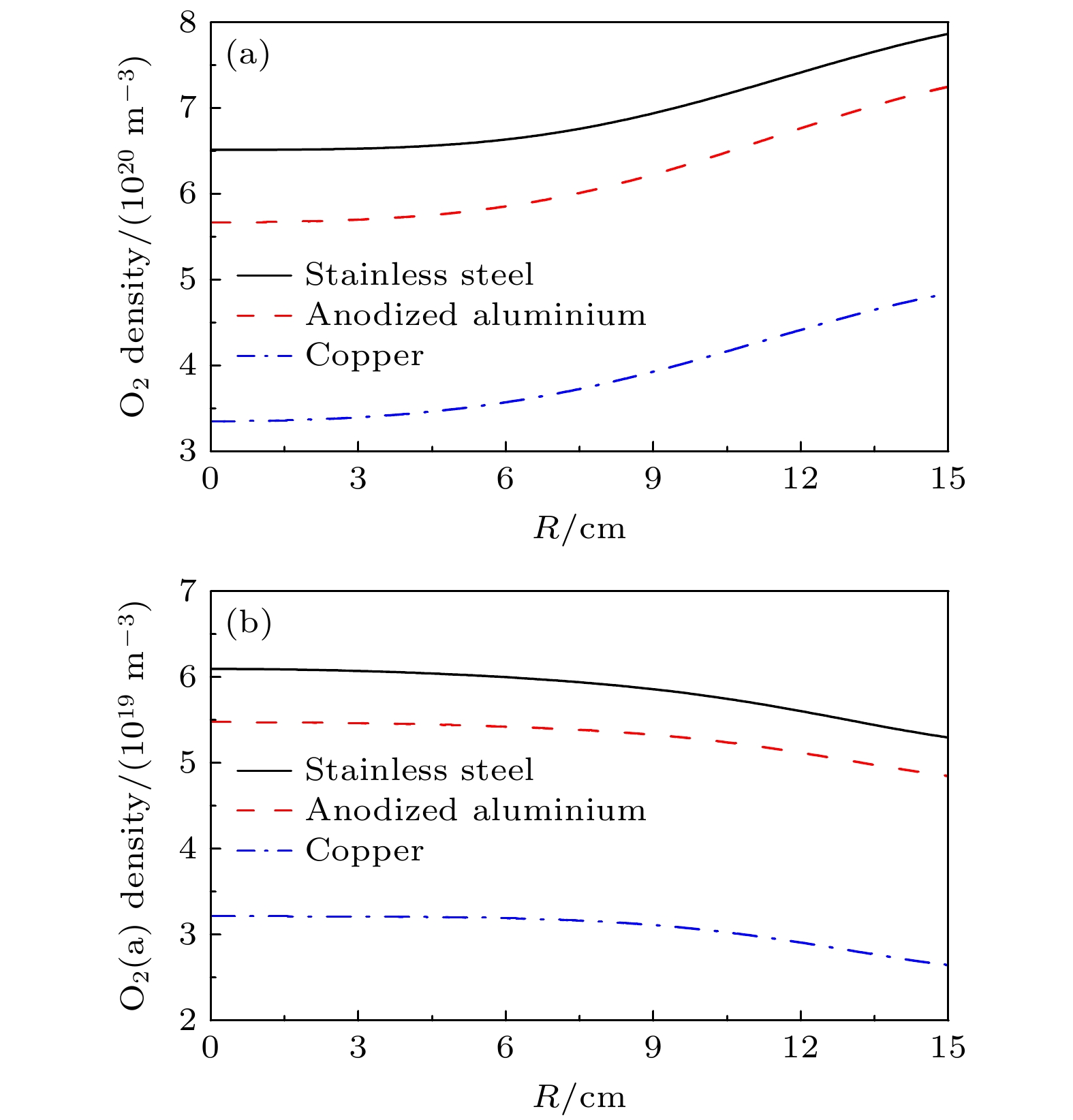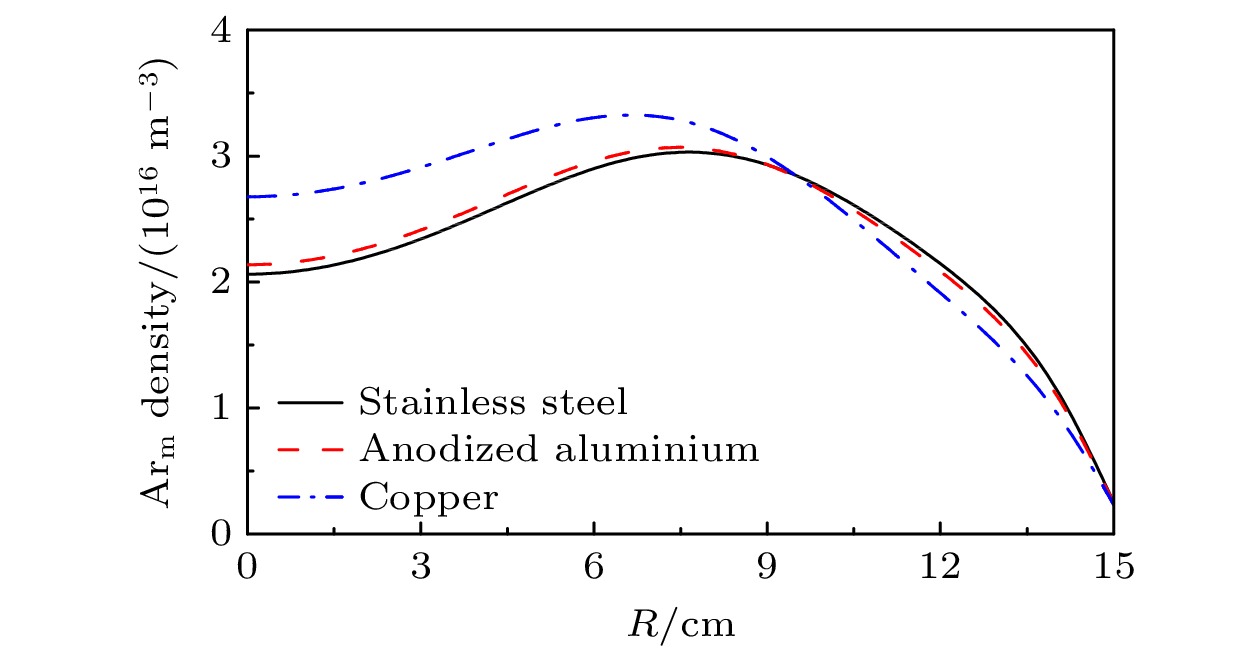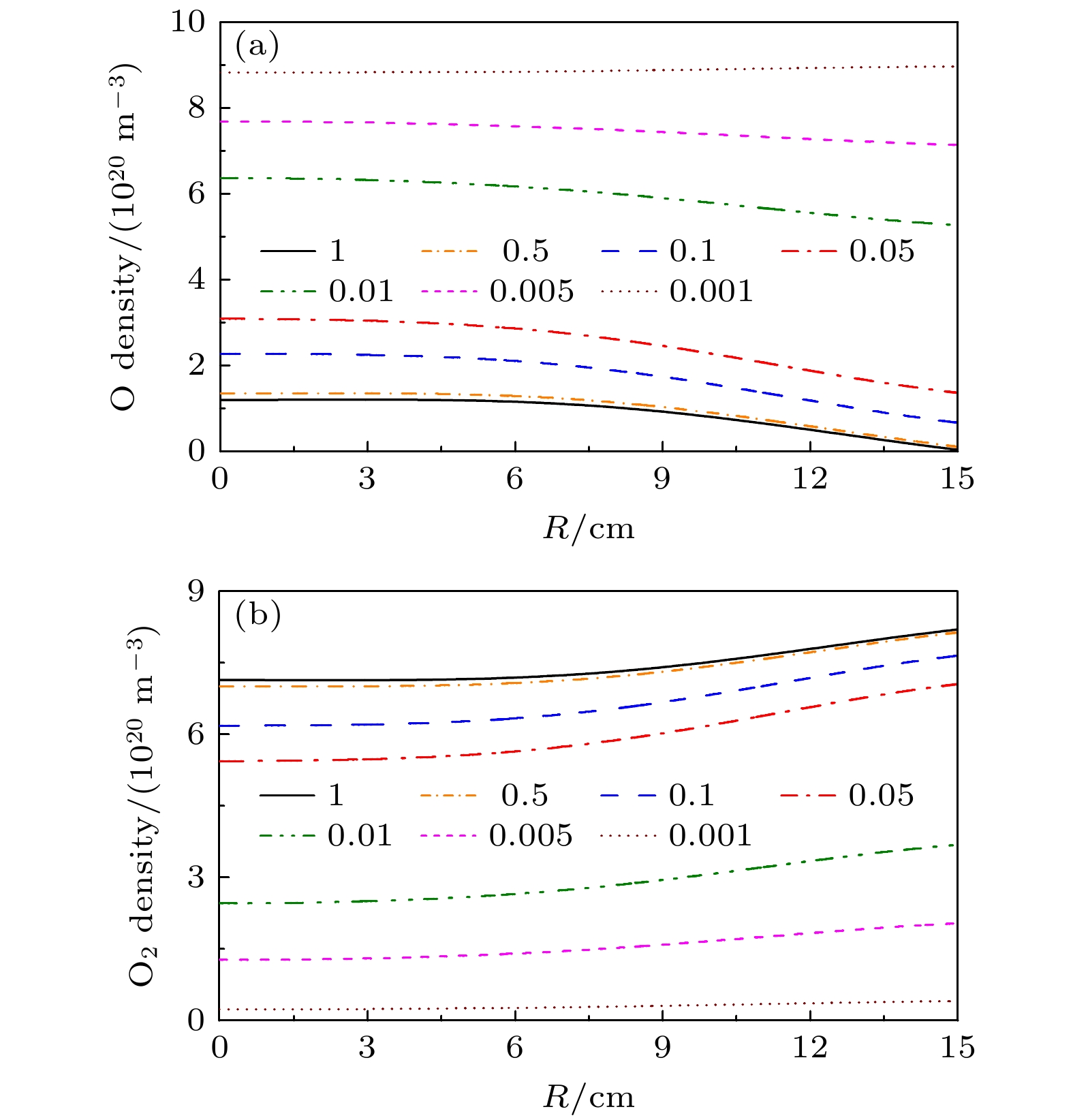-
本文采用流体力学模型对不同腔室材质下的感性耦合Ar/O2等离子体放电特性进行研究. 结果表明, 由于中性粒子在不同材质表面的黏附系数不同, 因而腔室材质对各活性粒子的密度和空间分布产生了显著的影响. 依次采用不锈钢、阳极Al2O3和Cu腔室进行放电, 发现电子、O+、Ar+、O、O(1D)和Arm的密度逐渐增大,
$ {\text{O}}_2^ + $ , O–, O2和$ {{{\mathrm{O}}} _2}\left( {{{\mathrm{a}}^1}{\Delta _{\mathrm{g}}}} \right) $ 的密度变化趋势相反, 各粒子的空间分布特点也有明显差异. 在不同腔室中, 电子在腔室中心区域的分布是均匀的; O和$ {{{\mathrm{O}}} _2}\left( {{{\mathrm{a}}^1}{\Delta _{\mathrm{g}}}} \right) $ 的密度最大值位于腔室中心, 并沿径向逐渐降低; 而Ar+和Arm的密度峰值出现在线圈下方; O+,$ {\text{O}}_2^ + $ 和O(1D)的密度最大值却随着腔室的变化从线圈下方逐渐向腔室中心方向移动; O–离子则被局域在线圈和极板之间一个非常小的区域. 最后, 讨论了表面反应O → 1/2O2的黏附系数对O和O2的影响, 发现随着黏附系数的增大, O密度逐渐降低, O2密度变化趋势相反, 而且当黏附系数增大到0.5以上时, 二者的密度几乎不再受黏附系数的影响.In the inductively coupled plasma (ICP) discharge, surface processes, such as reflection, de-excitation, and recombination, can occur when active species arrive at material surfaces, which accordingly influences the plasma properties. In this work, a fluid model is used to study the Ar/O2 plasma generated by ICP reactors made of different materials. In simulation, sticking coefficient is employed to estimate the surface reactions on different materials. As the reactor material changes from stainless steel to anodized aluminum to Cu, the sticking coefficient of surface reaction O→1/2O2 decreases accordingly. It is found that the reactor material has a great effect on species density. In the stainless steel reactor, the density of O atoms at grounded state and excited state are much lower because more O2 molecules are generated from the surface reaction, yielding a much higher density of$ {\text{O}}_2^ + $ molecular ions which are mainly created from the ionization process of O2 molecules. Similarly, the high density of O2 molecules also enhances the production of${{{\mathrm{O}}} _2}\left( {{{\mathrm{a}}^1}{\Delta _{\mathrm{g}}}} \right)$ molecules through the excitation process and O– ions through the dissociation attachment reaction. On the contrary, more electrons are consumed via the collisions between electrons and O2 molecules or$ {\text{O}}_2^ + $ molecular ions. Therefore, the electron density obtained in the Cu reactor is highest. The density of Ar+ ions and Arm atoms also increase with sticking coefficient decreasing. The density of O+ ions and$ {\text{O}}_2^ + $ molecular ions peak below the coil in the stainless steel reactor, whereas the radial uniformities are improved in the Cu reactor. In the three reactors, the electrons distribute evenly at the reactor center region. The O density and${{{\mathrm{O}}} _2}\left( {{{\mathrm{a}}^1}{\Delta _{\mathrm{g}}}} \right)$ density significantly peak at the reactor center, while the maximum value of Ar+ density and Arm density are below the coil. As for O(1D), the maximum density below the coil region moves toward the reactor center as the reactor material changes from stainless steel to Cu. Finally, the effect of sticking coefficient of O→1/2O2 is studied. The results show that the O atom density decreases with the sticking coefficient increasing, but the opposite trend is observed in O2 molecular density. It is noticed that the sticking coefficient has little effect on species density when it is higher than 0.5.-
Keywords:
- inductively coupled plasma /
- Ar/O2 plasma /
- reactor material /
- fluid simulation
[1] Liu Y X, Zhang Q Z, Zhao K, Zhang Y R, Gao F, Song Y H, Wang Y N 2022 Chin. Phys. B 31 085202
 Google Scholar
Google Scholar
[2] Tiyyagura H R, Puliyalil H, Filipič G, et al. 2020 Surf. Coat. Technol. 385 125434
 Google Scholar
Google Scholar
[3] Zhang Z Y, Ye Z B, Wang Z J, et al. 2019 Appl. Surf. Sci. 475 143
 Google Scholar
Google Scholar
[4] Farias C E, Bianchi J C, Oliveira P R, et al. 2014 Mater. Res. 17 1251
 Google Scholar
Google Scholar
[5] Cao F, Wang Y D, Li L, Guo B J, An Y P 2009 Scripta Mater. 61 231
 Google Scholar
Google Scholar
[6] Ono T, Akagi T, Ichiki T 2009 J. Appl. Phys. 105 013314
 Google Scholar
Google Scholar
[7] 范惠泽, 刘凯, 黄永清, 蔡世伟, 任晓敏, 段晓峰, 王琦, 刘昊, 吴瑶 2017 真空科学与技术学报 37 286
 Google Scholar
Google Scholar
Fan H Z, Liu K, Huang Y Q, Cai S W, Ren X M, Duan X F, Wang Q, Liu H, Wu Y 2017 Chin. J. Vac. Sci. Technol. 37 286
 Google Scholar
Google Scholar
[8] Hoffman A, Gu Y, Tokash J, Tokash J, Woodward J, Rack P D 2020 ACS Appl. Mater. Interfaces 12 7345
 Google Scholar
Google Scholar
[9] Chung T H, Kang H R, Bae M K 2012 Phys. Plasmas 19 113502
 Google Scholar
Google Scholar
[10] Hsu C C, Nierode M A, Coburn J W, Graves D B 2006 J. Phys. D: Appl. Phys. 39 3272
 Google Scholar
Google Scholar
[11] Du P C, Gao F, Wang X K, Liu Y X, Wang Y N 2021 Chin. Phys. B 30 035202
 Google Scholar
Google Scholar
[12] Han X, Wei X, Xu H, Zhang W, Li Y, Li Y, Yang Z 2019 Vacuum 168 108821
 Google Scholar
Google Scholar
[13] 王彦洁 2018 硕士学位论文(大连: 大连理工大学)
Wang Y J 2018 M. S. Dissertation (Dalian: Dalian University of Technology
[14] Chen J L, Xu H J, Wei X L, Lü H Y, Song Z S, Chen Z H 2017 Vacuum 145 77
 Google Scholar
Google Scholar
[15] Wan Y H, Liu W, Zhang Y R, Wang Y N 2015 Chin. Phys. B 24 095203
 Google Scholar
Google Scholar
[16] Wen D Q, Zhang Y R, Lieberman M A, Wang Y N 2017 Plasma Process. Polym. 14 e1600100
 Google Scholar
Google Scholar
[17] 佟磊, 赵明亮, 张钰如, 宋远红, 王友年 2024 物理学报 73 045201
 Google Scholar
Google Scholar
Tong L, Zhao M L, Zhang Y R, Song Y H, Wang Y N 2024 Acta Phys. Sin. 73 045201
 Google Scholar
Google Scholar
[18] Xue C, Gao F, Wen D Q, Wang Y N 2019 J. Appl. Phys. 125 023303
 Google Scholar
Google Scholar
[19] Liu W, Xue C, Gao F, Liu Y X, Wang Y N, Zhao Y T 2021 Chin. Phys. B 30 065202
 Google Scholar
Google Scholar
[20] 孙晓艳 2017 博士学位论文(大连: 大连理工大学)
Sun X Y 2017 Ph. D. Dissertation (Dalian: Dalian University of Technology
[21] Shibata M, Nakano N, Makabe T 1996 J. Appl. Phys. 80 6142
 Google Scholar
Google Scholar
[22] Toneli D A, Pessoa R S, Roberto M, Gudmundsson J T 2015 J. Phys. D: Appl. Phys. 48 495203
 Google Scholar
Google Scholar
[23] Zhao X Q, Liang Y S, Guo Y Y 2022 Phys. Plasmas 29 113511
 Google Scholar
Google Scholar
[24] Zhang Y R, Gao F, Li X C, Bogaerts A, Wang Y N 2015 J. Vac. Sci. Technol. A 33 061303
 Google Scholar
Google Scholar
[25] Zhang Y R, Hu Y T, Gao F, Song Y H, Wang Y N 2018 Plasma Source Sci. Technol. 27 055003
 Google Scholar
Google Scholar
[26] Sun X Y, Zhang Y R, Li X C, Wang Y N 2017 Chin. Phys. B 26 015201
 Google Scholar
Google Scholar
[27] Liang Y S, Liu Y X, Zhang Y R, Wang Y N 2020 J Appl. Phys. 127 133301
 Google Scholar
Google Scholar
[28] Liang Y S, Xue C, Zhang Y R, Wang Y N 2021 Phys. Plasmas 28 013510
 Google Scholar
Google Scholar
[29] Bogaerts A 2009 Spectrochim. Acta B 64 126
 Google Scholar
Google Scholar
[30] Gudmundsson J T, Thorsteinsson E G 2007 Plasma Sources Sci. Technol. 16 399
 Google Scholar
Google Scholar
[31] Gomez S, Stern P G, Graham W G 2002 Appl. Phys. Lett. 81 19
 Google Scholar
Google Scholar
[32] Singh H, Coburn J W, Graves D B 2000 J. Appl. Phys. 88 3748
 Google Scholar
Google Scholar
[33] Matsushita J, Sasaki K, Kadota K 1997 Jpn. J. Appl. Phys. 36 4747
 Google Scholar
Google Scholar
[34] Mozetič M, Zalar A 2000 Appl. Surf. Sci. 158 263
 Google Scholar
Google Scholar
[35] Booth J P, Sadeghi N 1991 J. Appl. Phys. 70 611
 Google Scholar
Google Scholar
[36] Lee C, Lieberman M A 1995 J. Vac. Sci. Technol. A 13 368
 Google Scholar
Google Scholar
[37] Guha J, Kurunczi P, Stafford L, Donnelly V M, Pu Y K 2008 J. Phys. Chem. C 112 8963
 Google Scholar
Google Scholar
[38] Kitajima T, Nakano T, Makabe T 2006 Appl. Phys. Lett. 88 091501
 Google Scholar
Google Scholar
[39] Sharpless R L, Slanger T G 1989 J. Chem. Phys. 91 7947
 Google Scholar
Google Scholar
[40] O'Brien Jr R J, Myers G H 1970 J. Chem. Phys. 53 3832
 Google Scholar
Google Scholar
[41] Vidaud P H, Wayne R P, Yaron M 1976 Chem. Phys. Lett. 38 306
 Google Scholar
Google Scholar
[42] Thorsteinsson E G, Gudmundsson J T 2010 Plasma Sources Sci. Technol. 19 055008
 Google Scholar
Google Scholar
[43] Gudmundsson J, Kimura T, Lieberman M 1999 Plasma Sources Sci. Technol. 8 22
 Google Scholar
Google Scholar
[44] Kiehlbauch M W, Graves D B 2003 J. Vacuum Sci. Technol. A 21 660
 Google Scholar
Google Scholar
[45] Liu W, Wen D Q, Zhao S X, Gao F, Wang Y N 2015 Plasma Sources Sci. Technol. 24 025035
 Google Scholar
Google Scholar
[46] Toneli D A, Pessoa R S, Roberto M, Gudmundsson J T 2015 J. Phys. D: Appl. Phys. 48 325202
 Google Scholar
Google Scholar
-
表 1 模型中考虑的表面反应
Table 1. Surface reactions considered in the model.
序号 表面反应 黏附系数 不锈钢 阳极Al2O3 Cu S1 Arr → Ar 1.0 S2 Arm → Ar 1.0 S3 Ar(4p) → Ar 1.0 S4 O → 1/2O2 0.156 0.06 0.015 S5 O(D) → 1/2O2 S6 O2(a) → O2 0.007 0.007 0.014 S7 O2(b) → O2 0.1 表 2 不同材质腔室下电子功率沉积密度最大值
Table 2. Maximum of electron deposition power density generated by different reactors.
腔室材料 电子沉积功率密度/(W·m–3) R向 Z向 角向 不锈钢 3.01×104 1.95×105 6.14×105 阳极Al2O3 3.33×104 2.06×105 6.12×105 Cu 4.86×104 2.52×105 6.15×105 -
[1] Liu Y X, Zhang Q Z, Zhao K, Zhang Y R, Gao F, Song Y H, Wang Y N 2022 Chin. Phys. B 31 085202
 Google Scholar
Google Scholar
[2] Tiyyagura H R, Puliyalil H, Filipič G, et al. 2020 Surf. Coat. Technol. 385 125434
 Google Scholar
Google Scholar
[3] Zhang Z Y, Ye Z B, Wang Z J, et al. 2019 Appl. Surf. Sci. 475 143
 Google Scholar
Google Scholar
[4] Farias C E, Bianchi J C, Oliveira P R, et al. 2014 Mater. Res. 17 1251
 Google Scholar
Google Scholar
[5] Cao F, Wang Y D, Li L, Guo B J, An Y P 2009 Scripta Mater. 61 231
 Google Scholar
Google Scholar
[6] Ono T, Akagi T, Ichiki T 2009 J. Appl. Phys. 105 013314
 Google Scholar
Google Scholar
[7] 范惠泽, 刘凯, 黄永清, 蔡世伟, 任晓敏, 段晓峰, 王琦, 刘昊, 吴瑶 2017 真空科学与技术学报 37 286
 Google Scholar
Google Scholar
Fan H Z, Liu K, Huang Y Q, Cai S W, Ren X M, Duan X F, Wang Q, Liu H, Wu Y 2017 Chin. J. Vac. Sci. Technol. 37 286
 Google Scholar
Google Scholar
[8] Hoffman A, Gu Y, Tokash J, Tokash J, Woodward J, Rack P D 2020 ACS Appl. Mater. Interfaces 12 7345
 Google Scholar
Google Scholar
[9] Chung T H, Kang H R, Bae M K 2012 Phys. Plasmas 19 113502
 Google Scholar
Google Scholar
[10] Hsu C C, Nierode M A, Coburn J W, Graves D B 2006 J. Phys. D: Appl. Phys. 39 3272
 Google Scholar
Google Scholar
[11] Du P C, Gao F, Wang X K, Liu Y X, Wang Y N 2021 Chin. Phys. B 30 035202
 Google Scholar
Google Scholar
[12] Han X, Wei X, Xu H, Zhang W, Li Y, Li Y, Yang Z 2019 Vacuum 168 108821
 Google Scholar
Google Scholar
[13] 王彦洁 2018 硕士学位论文(大连: 大连理工大学)
Wang Y J 2018 M. S. Dissertation (Dalian: Dalian University of Technology
[14] Chen J L, Xu H J, Wei X L, Lü H Y, Song Z S, Chen Z H 2017 Vacuum 145 77
 Google Scholar
Google Scholar
[15] Wan Y H, Liu W, Zhang Y R, Wang Y N 2015 Chin. Phys. B 24 095203
 Google Scholar
Google Scholar
[16] Wen D Q, Zhang Y R, Lieberman M A, Wang Y N 2017 Plasma Process. Polym. 14 e1600100
 Google Scholar
Google Scholar
[17] 佟磊, 赵明亮, 张钰如, 宋远红, 王友年 2024 物理学报 73 045201
 Google Scholar
Google Scholar
Tong L, Zhao M L, Zhang Y R, Song Y H, Wang Y N 2024 Acta Phys. Sin. 73 045201
 Google Scholar
Google Scholar
[18] Xue C, Gao F, Wen D Q, Wang Y N 2019 J. Appl. Phys. 125 023303
 Google Scholar
Google Scholar
[19] Liu W, Xue C, Gao F, Liu Y X, Wang Y N, Zhao Y T 2021 Chin. Phys. B 30 065202
 Google Scholar
Google Scholar
[20] 孙晓艳 2017 博士学位论文(大连: 大连理工大学)
Sun X Y 2017 Ph. D. Dissertation (Dalian: Dalian University of Technology
[21] Shibata M, Nakano N, Makabe T 1996 J. Appl. Phys. 80 6142
 Google Scholar
Google Scholar
[22] Toneli D A, Pessoa R S, Roberto M, Gudmundsson J T 2015 J. Phys. D: Appl. Phys. 48 495203
 Google Scholar
Google Scholar
[23] Zhao X Q, Liang Y S, Guo Y Y 2022 Phys. Plasmas 29 113511
 Google Scholar
Google Scholar
[24] Zhang Y R, Gao F, Li X C, Bogaerts A, Wang Y N 2015 J. Vac. Sci. Technol. A 33 061303
 Google Scholar
Google Scholar
[25] Zhang Y R, Hu Y T, Gao F, Song Y H, Wang Y N 2018 Plasma Source Sci. Technol. 27 055003
 Google Scholar
Google Scholar
[26] Sun X Y, Zhang Y R, Li X C, Wang Y N 2017 Chin. Phys. B 26 015201
 Google Scholar
Google Scholar
[27] Liang Y S, Liu Y X, Zhang Y R, Wang Y N 2020 J Appl. Phys. 127 133301
 Google Scholar
Google Scholar
[28] Liang Y S, Xue C, Zhang Y R, Wang Y N 2021 Phys. Plasmas 28 013510
 Google Scholar
Google Scholar
[29] Bogaerts A 2009 Spectrochim. Acta B 64 126
 Google Scholar
Google Scholar
[30] Gudmundsson J T, Thorsteinsson E G 2007 Plasma Sources Sci. Technol. 16 399
 Google Scholar
Google Scholar
[31] Gomez S, Stern P G, Graham W G 2002 Appl. Phys. Lett. 81 19
 Google Scholar
Google Scholar
[32] Singh H, Coburn J W, Graves D B 2000 J. Appl. Phys. 88 3748
 Google Scholar
Google Scholar
[33] Matsushita J, Sasaki K, Kadota K 1997 Jpn. J. Appl. Phys. 36 4747
 Google Scholar
Google Scholar
[34] Mozetič M, Zalar A 2000 Appl. Surf. Sci. 158 263
 Google Scholar
Google Scholar
[35] Booth J P, Sadeghi N 1991 J. Appl. Phys. 70 611
 Google Scholar
Google Scholar
[36] Lee C, Lieberman M A 1995 J. Vac. Sci. Technol. A 13 368
 Google Scholar
Google Scholar
[37] Guha J, Kurunczi P, Stafford L, Donnelly V M, Pu Y K 2008 J. Phys. Chem. C 112 8963
 Google Scholar
Google Scholar
[38] Kitajima T, Nakano T, Makabe T 2006 Appl. Phys. Lett. 88 091501
 Google Scholar
Google Scholar
[39] Sharpless R L, Slanger T G 1989 J. Chem. Phys. 91 7947
 Google Scholar
Google Scholar
[40] O'Brien Jr R J, Myers G H 1970 J. Chem. Phys. 53 3832
 Google Scholar
Google Scholar
[41] Vidaud P H, Wayne R P, Yaron M 1976 Chem. Phys. Lett. 38 306
 Google Scholar
Google Scholar
[42] Thorsteinsson E G, Gudmundsson J T 2010 Plasma Sources Sci. Technol. 19 055008
 Google Scholar
Google Scholar
[43] Gudmundsson J, Kimura T, Lieberman M 1999 Plasma Sources Sci. Technol. 8 22
 Google Scholar
Google Scholar
[44] Kiehlbauch M W, Graves D B 2003 J. Vacuum Sci. Technol. A 21 660
 Google Scholar
Google Scholar
[45] Liu W, Wen D Q, Zhao S X, Gao F, Wang Y N 2015 Plasma Sources Sci. Technol. 24 025035
 Google Scholar
Google Scholar
[46] Toneli D A, Pessoa R S, Roberto M, Gudmundsson J T 2015 J. Phys. D: Appl. Phys. 48 325202
 Google Scholar
Google Scholar
计量
- 文章访问数: 5015
- PDF下载量: 186
- 被引次数: 0

















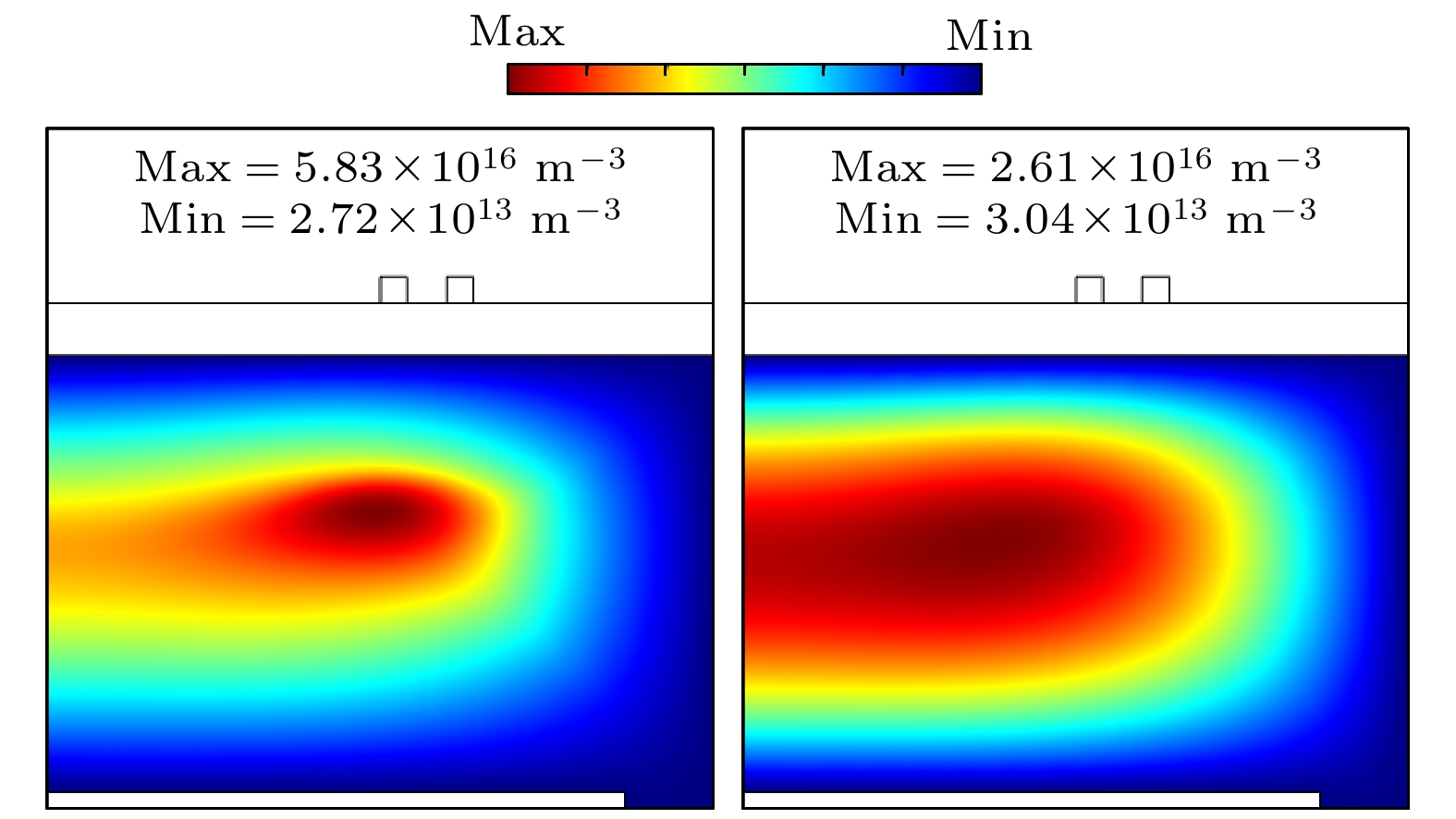
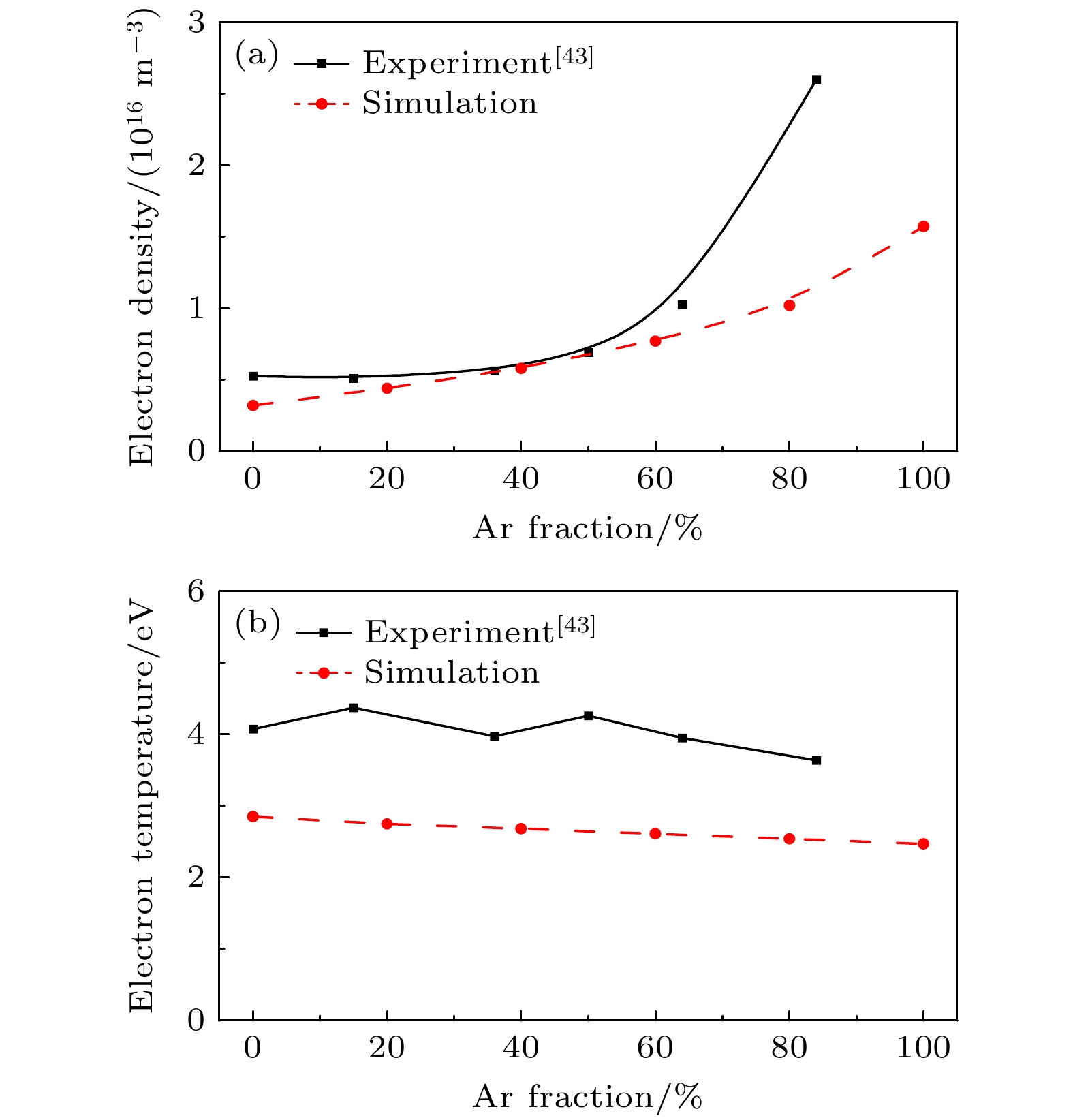
 下载:
下载:
